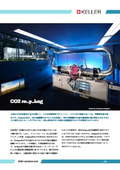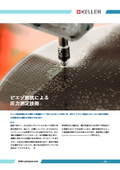Keller Company Pressure Sensor Series 33X
High-precision pressure sensor with RS485 digital output. Atmospheric pressure range (800 to 1200 hPa) is also available!
The pressure sensor 33X achieves an extremely high accuracy of 0.05% full scale (FS) in the temperature range of 10 to 40°C through a mathematical correction method. An additional option for high precision of 0.01% FS is also available. In addition to a digital RS485 interface, analog current or voltage outputs can be obtained. 【Features】 - Accuracy of ±0.05% FS in the temperature range of 10 to 40°C - Standard dual outputs of digital RS485 and analog output - Analog output can be range-adjusted via digital RS485 - Available in barometric range type (800–1200 hPa) and differential pressure range type (from 0–30 kPa to 0–3 MPa) - Temperature range of -20 to 125°C (optional -40°C also available) - Excellent long-term stability 【Technology】 - Piezo-resistive pressure sensor - Correction technology using a mathematical model to produce accurate pressure values
basic information
Pressure range: 0 to 30 kPa to 0…100 MPa Accuracy: ± 0.05 %FS @ 10–40°C Overall accuracy: ± 0.1 %FS @ -10…80 °C Output: RS485, 4–20 mA, 0–10 V, 0–5 V, etc. Temperature range: -20…125 °C *Software CCS30 The license-free software CCS30 is used for settings and recording measurement values. Measurement - Real-time graphic display - Adjustable measurement and saving intervals - Export function - Connection to bus systems - Up to 100 measurements per second Settings - Information retrieval (pressure and temperature range, software version, serial number, etc.) - Zero and span recalibration - Analog output rescaling (units, pressure range) - Low-pass filter adjustment - Selection of instrument address and baud rate
Price range
Delivery Time
Applications/Examples of results
Engine test bench Industrial and automation applications Hydraulic measurement Pressure gauge reference instrument
Related Videos
catalog(13)
Download All Catalogs

News about this product(9)
-

A pressure sensor that can change the pressure range! There's no need to prepare separate sensors for each range!
KELLER Pressure offers pressure sensors with models that allow for adjustable pressure ranges. There is no need to have separate sensors for each pressure range, as one unit can comprehensively cover all ranges. This significantly contributes to cost reduction. Additionally, there is no need to worry about delivery times for additional orders. The compatible models include OEM types, general-purpose types, high-precision types, and explosion-proof types, among others. We also conduct demonstrations on how to change the pressure range, so please feel free to contact us if you would like more details. Series 23SX (General-purpose type) Series 33X (High-precision type) Series 10LX, 20SX (OEM type) Series 41X (Low-pressure type) Differential pressure type Explosion-proof type
-

KELLER will exhibit at the International Space Business Expo SPEXA! July 30 to August 1, 2025, at Tokyo Big Sight, South Hall 3, S4-2.
KELLER Pressure is a leading manufacturer of piezoresistive pressure sensors. We are showcasing high-precision pressure sensors, compact pressure sensors, and high-speed response pressure sensors, including pressure sensors and digital pressure gauges with proven performance in the aerospace and aviation fields. We will explain why KELLER Pressure products are chosen in the aerospace and aviation sectors and what sets them apart from competitors using our displayed products. 【Example of Achievements】 Rocket (fuel, oxidizer), satellites (atmospheric pressure measurement during atmospheric entry), combustion pressure measurement, aircraft attitude control, detonation, International Space Station (ISS), etc. For those wishing to have meetings or product introductions at our booth on the day of the event, we are accepting reservations in advance. If you are interested, please contact sales.jp@keller-pressure.com. 【Exhibition Content】 We offer a variety of pressure sensors suitable for a wide range of measurements: - Low pressure to high pressure (0.5 kPa to 200 MPa) - Low temperature to ultra-high temperature (-50°C to 1000°C) - High precision (± 0.01% FS and above) - Compact (Φ 1.4 x 3.1 cm and above) - Ultra-fast response - Digital display pressure gauges
-

KELLER will exhibit at the International Space Business Expo SPEXA! July 30 to August 1, 2025, at Tokyo Big Sight, South Hall 3, S4-2.
KELLER Pressure is a leading manufacturer of piezoresistive pressure sensors. We will showcase high-precision pressure sensors, compact pressure sensors, and fast-response pressure sensors with the specifications listed below, focusing on pressure sensors and digital pressure gauges that have a proven track record in the aerospace and aviation fields. We will explain why KELLER Pressure products are chosen in the aerospace and aviation sectors and what sets them apart from other companies using the displayed products. [Example of Achievements] Rockets (fuel, oxidizer), satellites (atmospheric pressure measurement during re-entry), combustion pressure measurement, aircraft attitude control, detonation, International Space Station (ISS), etc. For those who wish to have meetings or product introductions at our booth on the day of the event, we are accepting reservations in advance. If you are interested, please contact sales.jp@keller-pressure.com. [Exhibition Content] We offer a variety of pressure sensors suitable for a wide range of measurements: - Low pressure to high pressure (0.5 kPa to 200 MPa) - Low temperature to ultra-high temperature (-50°C to 1000°C) - High precision (± 0.01% FS and above) - Compact (Φ 1.4 x 3.1 cm and above) - Ultra-fast response - Digital display pressure gauges
-

KELLER pressure sensors with a strong track record in the aerospace field!
KELLER Pressure has been supplying pressure sensors to a wide range of sectors in the aerospace industry since 1997, and its pressure measurement technology has proven its reliability over hundreds of thousands of hours of flight. Reliability is paramount in the aerospace field, and the products used have proven themselves in this regard. 【Example of Achievements: Space Sector】 - Rockets (fuel, oxidizer) - Satellites (barometric measurement during atmospheric entry) - Combustion pressure measurement - Aircraft attitude control - Detonation - International Space Station (ISS) 【Example of Achievements: Aviation Sector】 - Pressure control in the cabin - Hydraulic distributors and filters - Valve control - Fuel pumps - Refueling systems - Air conditioning systems - Ventilation - Emergency oxygen supply to pilots You can see how different each application is and how broad the demands for pressure measurement technology are. Custom solutions are possible, but KELLER's strength lies in its many achievements with standard catalog products. This significantly improves parts procurement and management, costs, and delivery times. Please feel free to consult with KELLER, which has strong expertise in the aerospace field!
-

Sudden and Instantaneous Pressure Rise in a Closed System: Underestimated Risks and Their Mitigation Methods
Pressure peaks in closed systems can cause significant damage and are complex phenomena. But what exactly is a pressure peak? How does it occur, and how can we protect the system from pressure peaks? We will explain the role of precise measurements in ensuring the safety and efficiency of pressure systems. 1. What is a pressure peak? Why does it occur? The physical principles behind the phenomenon are Newton's three laws of motion and Bernoulli's principle. What causes water hammer and cavitation, and what are their effects? 2. Preventive measures Using simulations, protective components such as pressure dampers, pressure reducers, and check valves, as well as pressure sensors. 3. Why are pressure sensors necessary to protect the system from pressure peaks? Continuous monitoring with sensors allows for real-time recording of pressure peaks and can trigger automatic responses such as valve opening and closing. In the event of a failure of system components or protective devices, it can not only be directly detected but also prevented. Alarms can be automatically sent to responsible personnel via email, IoT, cloud, etc., in case of anomalies. For more details, please refer to the related links below!
Recommended products
Distributors
Our company is the Japanese branch of KELLER Pressure (Switzerland). Since its establishment, KELLER Pressure has developed and produced all its products at its factory in Winterthur, Switzerland, and is a leading manufacturer of pressure transducers and pressure transmitters, certified with ISO 9001. As a core business, we manufacture and sell over 1.3 million pressure measurement cells annually, offering products with pressure ranges from 5 mbar (500 Pa) to 2000 bar (200 MPa). With the extensive experience gained from all our products, our solutions can cater to a variety of applications. We are highly regarded as a manufacturer of high-precision pressure sensors and also accommodate OEM and custom products. We have received positive feedback from many customers. Contact: sales.jp@keller-pressure.com




























































